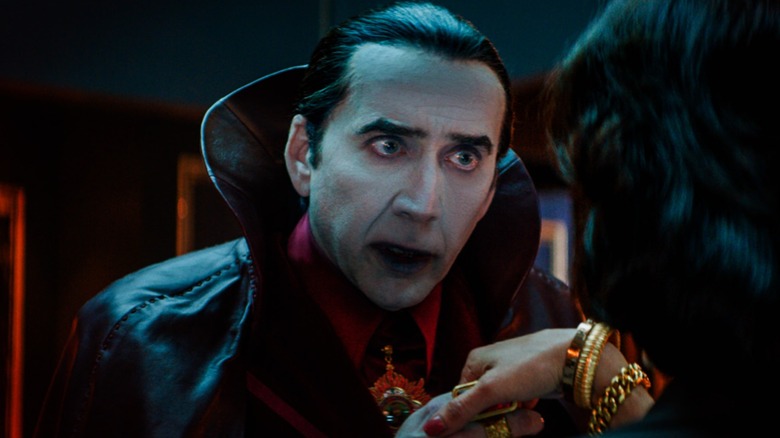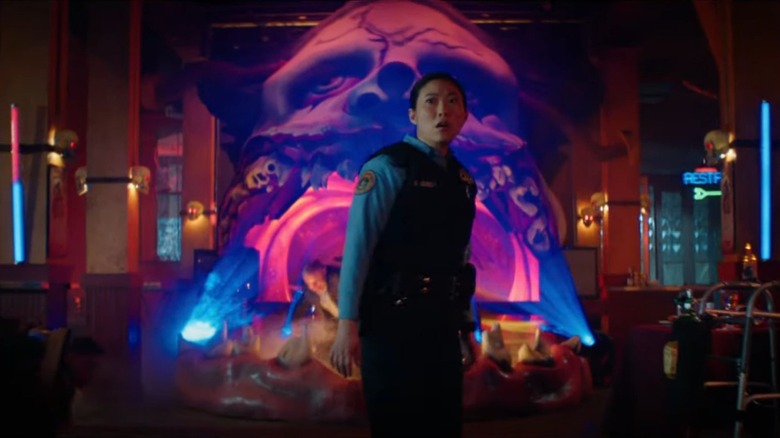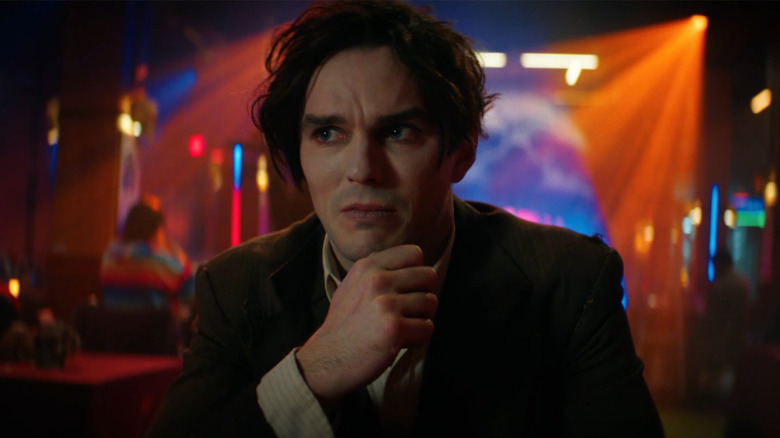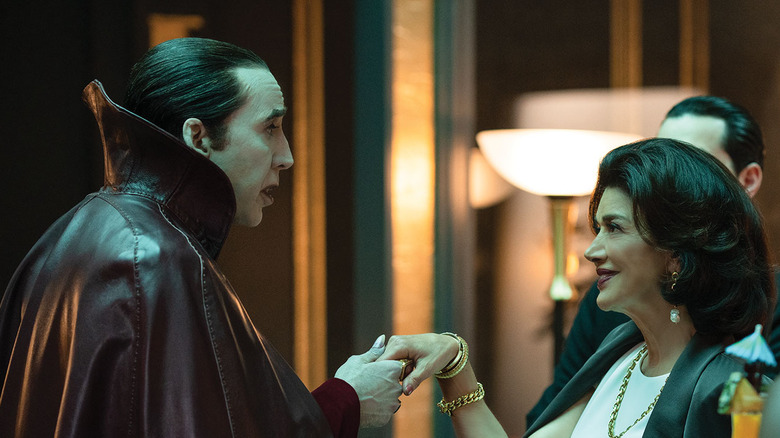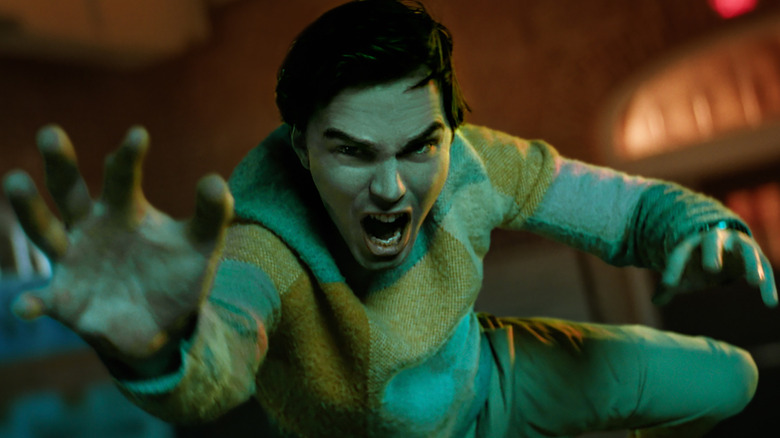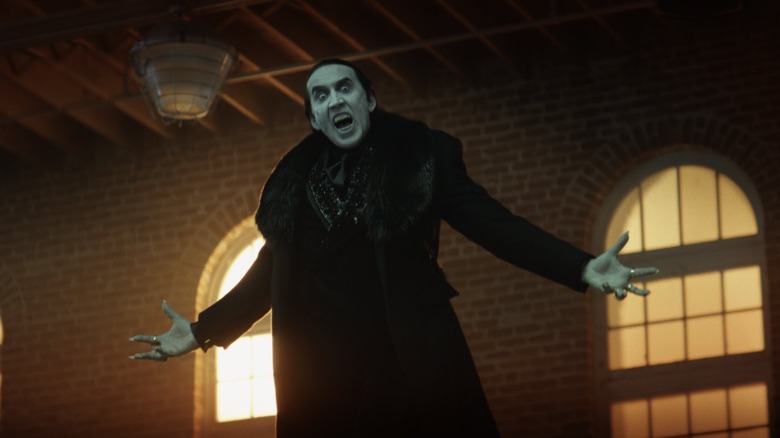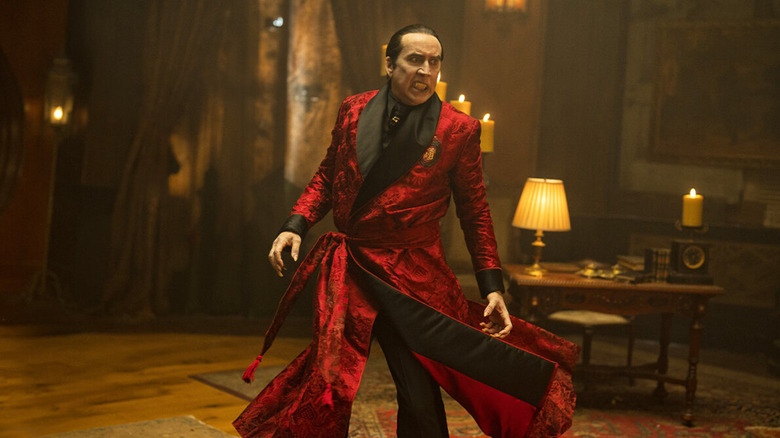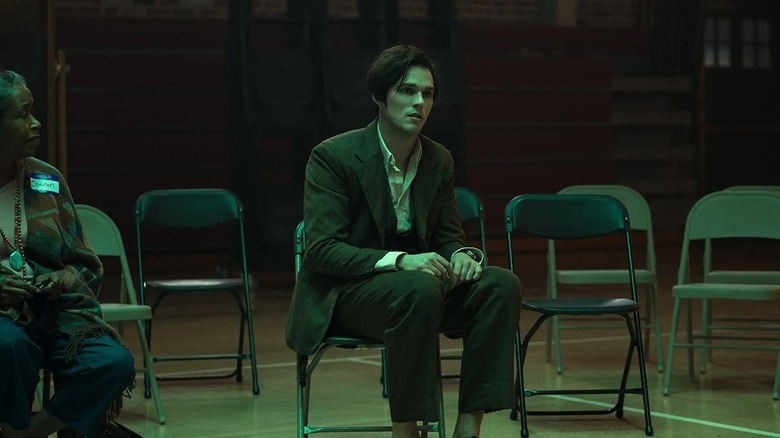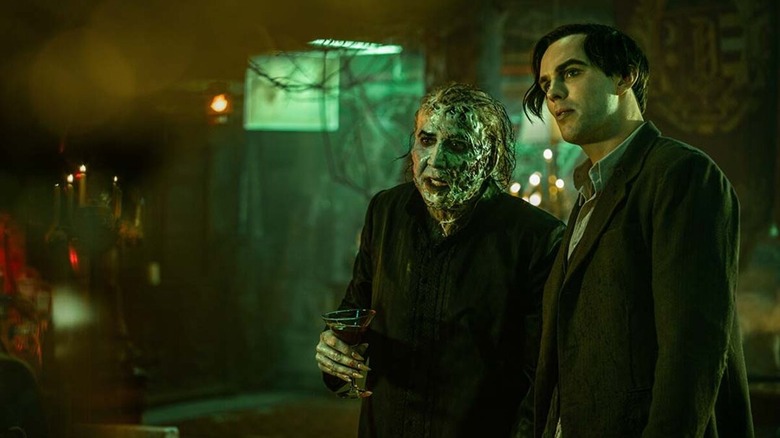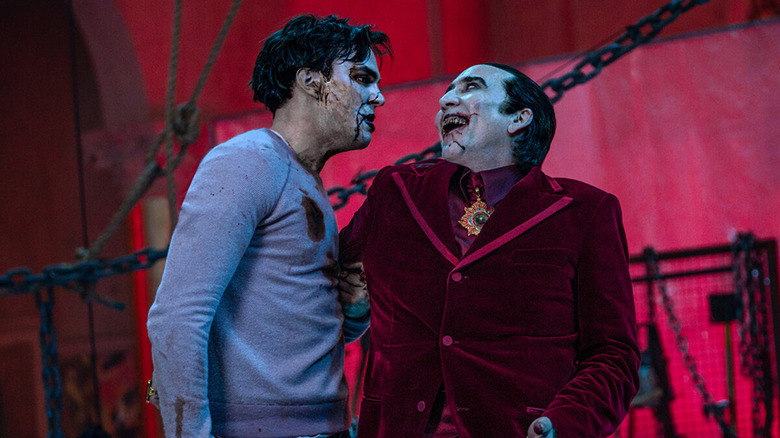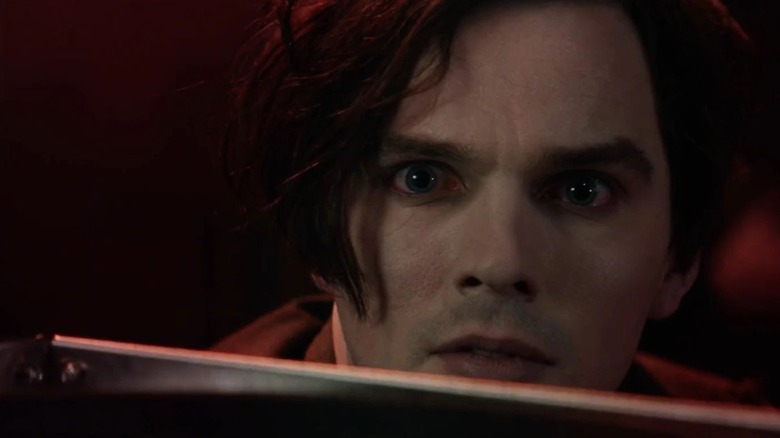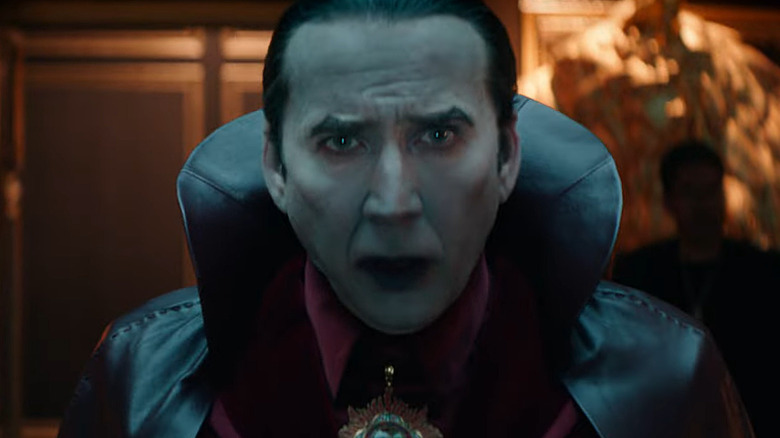The Ending Of Renfield Explained
We've all had bosses who drove us up the wall with their demanding nature or controlling impulses. But few have had to deal with bosses like the one R.M. Renfield (Nicholas Hoult) has to grapple with every day of his life. Based on a character from both Bram Stoker's novel "Dracula" and the original 1931 Universal monster movie of the same name, Renfield is the familiar to Count Dracula (Nicolas Cage), spending his days bringing carcasses for the vampire to devour. The new movie "Renfield" chronicles its titular lead trying to please his master in modern-day New Orleans, with Renfield being more conscious than ever that he's trapped in an unhealthy toxic relationship.
Trying to get out of that dynamic is always a challenge, especially when the toxic person you're dealing with is a bloodthirsty immortal. The movie follows Renfield confronting those challenges head-on as he attempts to create a new life for himself, incurring the wrath of both Dracula and the local Lobo crime family. The tonally-complicated antics that ensue from Renfield's endeavors eventually lead to an ending that throws a lot of blood, punching, and emotional catharsis at the viewer. So much is tossed at moviegoers that it can sometimes be difficult to keep track of what's happening and why. To help cut through all that chaos, let's break down the ending of "Renfield" and the ways it resolves the story of this beleaguered fixture of Dracula stories.
The calm before the storm
"Renfield" is generally a propulsive and loud movie, but for one moment before its big finale, there is calm. Renfield and police officer Rebecca Quincy (Awkwafina) recover from a grisly battle in an apartment complex at a small café, where the former character comes clean about leaving his wife and child behind to serve as Dracula's familiar. But all this relaxing vulnerability cannot last forever. The duo quickly learns that Count Dracula has a powerful new ally: the Lobo crime family. Not only that, but these gangsters have taken Rebecca's sister hostage. It's a frustrating plot detour for "Renfield" since the movie's gangsters haven't been as interesting as violent vampires, and it's a shame they're so focal in the finale.
However, this development ensures Quincy and Renfield both have skin in the game for the climax. Renfield is, as ever, impressed with Quincy's willingness to just charge into battle against those who wield power over her. This admiration that inspires Quincy to remind Renfield that anyone can stand up to bullies and abusive individuals. Inspired by Quincy's actions, and recognizing all the carnage that could be accomplished by Dracula teaming up with bloodthirsty mobsters, Renfield agrees to join Quincy in her fight against the forces of darkness. But they can't just go onto the battlefield empty-handed. Before they go, they'll have to use Renfield's decades of expertise in fighting back against Dracula's would-be destroyers to figure out the perfect weapons to kill a vampire.
It's time for a rescue
As the unforgettable opening chords of the My Chemical Romance song "Na Na Na (Na Na Na Na Na Na Na Na Na)" kick in on the soundtrack of "Renfield," one thing quickly becomes apparent: It's time for an energetic montage. Specifically, Renfield and Quincy gather up all the tools they'll need to fight Dracula and his minions. As they scramble across New Orleans looking for crucifixes and anything else traditionally associated with killing vampires, their determination to finally take out this narcissistic creep grows ever higher. But the most important weapon in the duo's arsenal is simply bugs. Since Renfield gets his supernatural powers from chomping on insects, it's time for him to go to every bait-and-tackle store in the nearby radius and buy as many tiny critters as possible to consume.
This mission results in a gross-out comedy moment in which Renfield gobbles down a horde of insects loudly in the passenger seat of Quincy's automobile, inspiring disgust from the driver. It's not a pretty sight, but it's a necessary one. Once all those bugs are inside Renfield's stomach, he's ready to confront danger head-on. It's a shame most of the weapons seen here (namely old-school vampire hunter tools like crucifixes) don't come into play in the ensuing finale, which renders this montage a bit superfluous. However, at least this sequence ensures that audiences get a welcome taste of My Chemical Romance.
The bloody violent (and visually frustrating) fights
The biggest issue with "Renfield" as a movie is, unfortunately, one that plagues its biggest set-pieces: director Chris McKay struggles with filming action sequences. Throughout the movie, McKay employs frantic cuts liable to take you out of the movie and make it difficult to parse out the finer nuances of the fight choreography. Anytime somebody's moving faster than a saunter in "Renfield," they're bound to be framed in editing and camerawork that's downright jarring. This issue is even apparent in the earliest moments of the movie's finale, as Renfield and Quincy face off against the various goons of mob boss Ella Lobo (Shoreh Aghdashloo).
Judging by their glowing eyes and her violent son Teddy (Ben Schwartz) snorting up a centipede like a line of cocaine, it's clear the members of Lobo's mob have been given supernatural vampire powers. This makes their fighting abilities extra powerful, though it's hard to take that in with the movie's penchant for capturing fight sequences or intensely suspenseful moments in such cluttered visual means. It doesn't help that the action we do see feels mighty repetitive quite fast, with Renfield's gruesome dispatching of vampire henchmen not looking much different than when he's killing plain human mobsters earlier in the film. While this stretch of the story reaffirms visual problems with "Renfield" as a movie, at least it gets our heroes to finally start squaring off with the feature's antagonists.
Lobo v. Renfield: Dawn of Vampires
While Renfield dispatches an assortment of random vampire-powered goons with ease, this long-suffering assistant to Dracula will need to work a little harder to ward off Teddy Lobo. Not only has the creep been given supernatural abilities, but Dracula has now chosen him to be his new familiar. This revelation makes the ensuing duel between Renfield and Lobo one between two sides of the same coin, with the protagonist having to duke it out with an unabashedly evil version of himself. All during their skirmish, Lobo is constantly taunting his opponent, including emphasizing how he's "the yin" to Renfield's "yang," which causes the film's lead character to observe that the duo's dynamic isn't quite as dramatic as all that. "We've barely met twice!" Renfield proclaims before Lobo attacks him in a rage.
Ryan Ridley's screenplay tries to sidestep the issue that this critical fight scene involves two characters who don't really have much of a pre-existing relationship, but lampshading the problem doesn't suddenly inject lots of underlying meaning into the duel. With no incredible editing or fight choreography to mitigate the lack of compelling dramatic stakes, this duel between Renfield and Lobo is flatter than it should be. This is true even with the over-the-top way Renfield takes out Lobo, which involves kicking the mobster so hard in the stomach that he spews out fluids from both ends before dying.
A deal with the devil, er, Dracula
While Renfield is off fighting Teddy Lobo, Quincy makes her way to the office of Ella Lobo, where she hopes to find her sister. Upon arriving, Ella greets the police officer only to suddenly vanish once the windows to the office are sealed shut. Now no sunlight can enter and impact a figure who's creeping up behind Quincy: Dracula. Now decked out in a fabulous red-colored cloak, Dracula doesn't go for the jugular here. Instead, he opts to make Quincy an offer. Her sister is dying from incredibly vicious wounds and the medicine of mortal men cannot save her. But the blood of Dracula, which can heal any wound, will be just the ticket for the pair (who both just lost their police officer father to the Lobo family).
Renfield bursts into the room just as Quincy is moving closer and closer to the embrace of Dracula. As he implores her not to become a follower of the dark lord, she remarks to him that she doesn't care about the consequences of being a confidante of Dracula — she just can't lose another member of her family. Quincy finally comes in for an embrace with Dracula, which caps off such a dramatic heel-turn that it's obvious way too far in advance that something is up. It turns out there is a plan in place: Quincy is hugging Dracula only to get closer to the button controlling the office windows.
An awkward shift from one battlefield to another
Quincy's betrayal of Dracula is followed up by the most awkward portion of the movie's climax. The clumsy writing of this stretch of the story is made immediately apparent by a strange moment where Quincy presses the button to open the windows ... and they don't open. She presses it two more times, cursing to herself that they're malfunctioning. This would seem to be a bit teeing up Quincy and Renfield needing to look for other ways to defeat Dracula, but instead, the windows immediately open after two more presses of the button. The brief malfunction could be cut entirely from the sequence — it doesn't even provide a brief gag.
As all that sunlight pours in, Dracula howls in pain and catches fire. To escape his surroundings, he turns into a pack of fire-covered bats. As he exits the room, it's revealed that Ella Lobo has just been hanging out in the hallway outside her office this whole time. She's then knocked to the ground unconscious by the fleeing bats, a tremendously abrupt way to get her out of the finale. After this moment, Renfield and Quincy track Dracula to a torture chamber in the Lobo family compound and continue their fight with the monster there. Clearly, screenwriter Ryan Ridley and director Chris McKay wanted to shift the action of "Renfield" from that office to a location filled with weapons the heroes could use. The transition between these two backdrops, though, is distractingly inelegant.
How to capture a vampire
Though the sun briefly deters him, Dracula's far from dead. Quincy and Renfield find him to still be an incredibly intimidating figure, and one who's still capable of levitating up into the air while grabbing the neck of mere mortal human Quincy. This is the moment where all hope looks especially lost, considering Renfield is collapsed on the ground, having succumbed to the various wounds he's incurred during the battle. Quincy's arms are just free enough to stab Dracula in the foot, a move that the vicious vampire initially laughs off as being a foolhardy attempt to save her life. However, this maneuver isn't meant to instantly kill Dracula or free Quincy.
Instead, it forces some blood out of Dracula's now-injured foot, where it can now drop onto Renfield and heal him. Quincy's plan ends up working like a charm, with that mystical blood reviving our hero, who promptly saves Quincy from the clutches of Dracula. The two confront each other and Renfield reaffirms what he heard in group meetings for people in abusive scenarios: victims in toxic relationships are the ones with all the power. After violently hammering this point home to Dracula, Quincy proceeds to trap the vampire in a spiritual containment field (which she learned to conjure up through "a wiccan Tumblr"). After so much bloodshed, Renfield has asserted his dominance over his old boss, and Dracula's finally been stopped in his tracks.
The brutal destruction of Dracula
It's not enough to just keep Dracula suspended in a circle, though — Renfield and Quincy have to destroy the beast. Luckily, the pair have cornered Dracula in a torture chamber loaded with weapons. After hearing Dracula's final words about wanting to spend a season in the deepest pits of Hell, Renfield and Quincy go to town on dismembering, burning, and torturing the vampire in every way imaginable. Renfield's recurring narration throughout the movie pops in again to remark to the audience that neither he nor his cohort could be exactly sure what would kill his old boss, so they tried to just throw everything at the wall and see what stuck.
Going this route inspires some of the more amusingly heightened gags in all of "Renfield." The inexplicable presence of entities like a cement mixer or an ice cube tray as ways of brutally killing Dracula are quite amusing sight gags on their own, while such cartoonish ways of dispatching a bloodsucker are far from common in the pantheon of vampire movies. Eventually, the barrage of sight gags and creative murders give way to Renfield and Quincy dispatching a bunch of chopped-up cubes of Dracula's corpse down a deep pit. Renfield himself notes in the narration that he's far from certain that this will kill off Dracula forever, but he certainly won't be able to heal easily.
The immediate aftermath of the battle
After taking care of Dracula, "Renfield" suddenly remembers it has another antagonist. Crime boss Ella doesn't get a very dramatic ending to her storyline, with the character just led away in handcuffs. Any previously urgent concerns about how Ella had bought off the local police have suddenly vanished, with law enforcement now inexplicably an ally our heroes can turn to. With Ella heading off to prison, Quincy has a reunion with her sister, who's been revived by Dracula's blood. The pair reconcile their differences, share a hug, and Quincy heads over to chat it up with Renfield. Now free of his master, Renfield is having an understandably complicated swirl of emotions.
Though he still doubts that he's much better than Dracula himself, Quincy reassures Renfield that he has provided something important to the world. When he asks what that is, Quincy clarifies that he's demonstrated that it's never too late for somebody to become a hero. It's a bit too tidy a moral for a feature whose violence sometimes wants to channel the grimy B-movie vibes of something like "Meet the Feebles," but at least this exchange cements the character arc Renfield has undergone. Plus, it lays the core theme of the entire film bare: even the enduringly loyal servant to a despicable vampire is capable of doing downright heroic deeds.
Bring me (and my friends) to life
Of all the "Star Trek" movies "Renfield" could've taken narrative cues from, it's doubtful anyone would expect it to be "Star Into Darkness." However, the final scene does indeed give off vibes of "Into Darkness," specifically regarding how magic blood is used to cure all problems. This parallel comes about in the final scene of "Renfield," when the movie's narration is revealed to be coming from Renfield speaking to his support group of people in abusive relationships. Previously, Dracula violently devoured and murdered all these souls, but they've now come back to life thanks to the power of the ghoul's blood. Though comments from support group leader Mark (Brendan Scott Jones) about how he's seen things in the afterlife that he cannot un-see indicate this isn't a consequence-free decision, everything still seems mostly fine.
Though clearly a way to give "Renfield" a happy ending, abruptly resurrecting so many people and leaning so hard on magic blood to solve all your movie's problems proves as frustrating here as it did in "Star Trek Into Darkness" a decade earlier. The camera even lingers on a jug of the blood (situated next to some cookies and napkins) for the final shot of the movie, as if to further remind viewers of such a strange narrative detail. "Renfield" has now reached a crowd-pleasing conclusion, though its strained ways of getting there leave much to be desired.
Any sequel teases lurking in the shadows?
Viewers expecting "Renfield" to conclude with teases for further adventures involving Nicolas Cage's Dracula will leave the film sorely disappointed. Though Renfield's line about not being sure if his and Quincy's violent actions have killed the vampire certainly leave the door open for the character to come back, "Renfield" as a movie ends on a definitively standalone note. There are no teases for potential sequels and no sequences are tucked away in various parts of the end credits. This is all meant to function as just one story, a sharp contrast to the 2017 Universal monster movie "The Mummy," which bent over backward to set up a slew of sequels and spin-offs.
Even with no set-up for a "Renfield 2," there's lots to digest in the movie's ending. Unfortunately, that includes how the climax crystallizes recurring problems with the movie as a whole, namely the struggles with realizing visually coherent action sequences. The tug-of-war between the movie's maximalist violent impulses and more standard narrative beats also reflects why the feature doesn't balance heart with shocking violence as well as, say, "Titane." Still, the final stretch of the picture does also reinforce how good Nicolas Cage and Nicholas Hoult are in their respective roles, and will undoubtedly send moviegoers with a soft spot for magic blood home with smiles on their faces.
